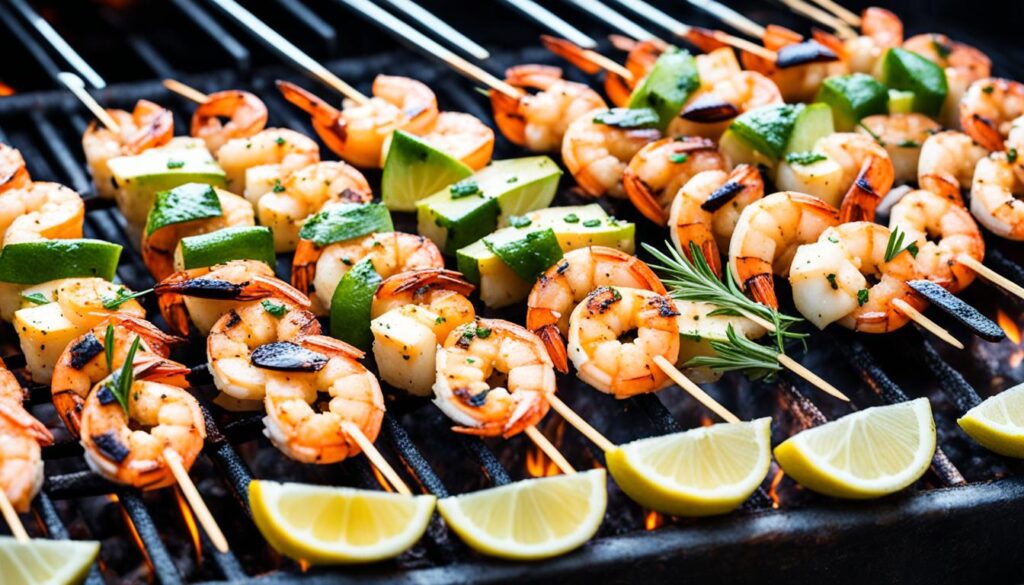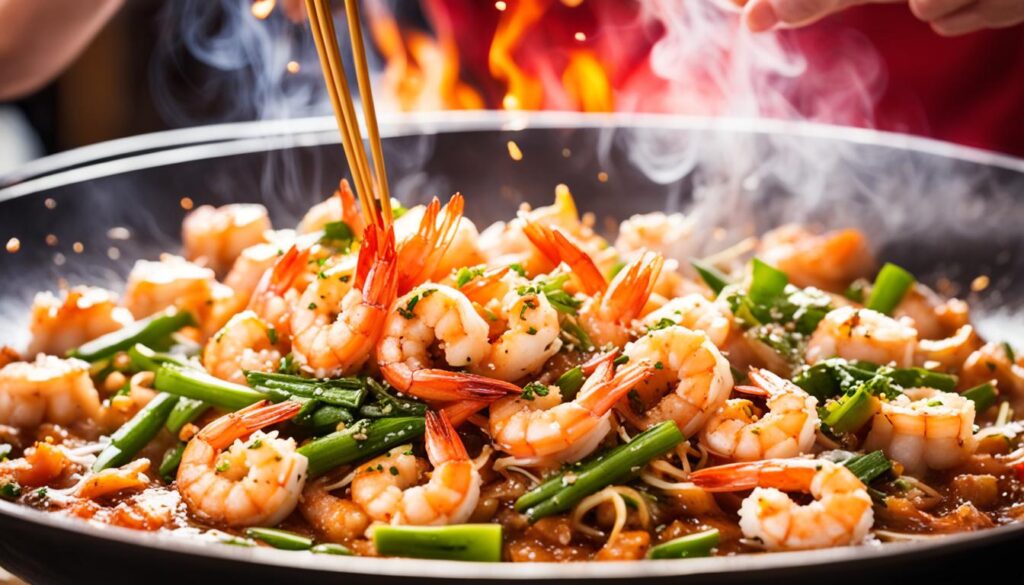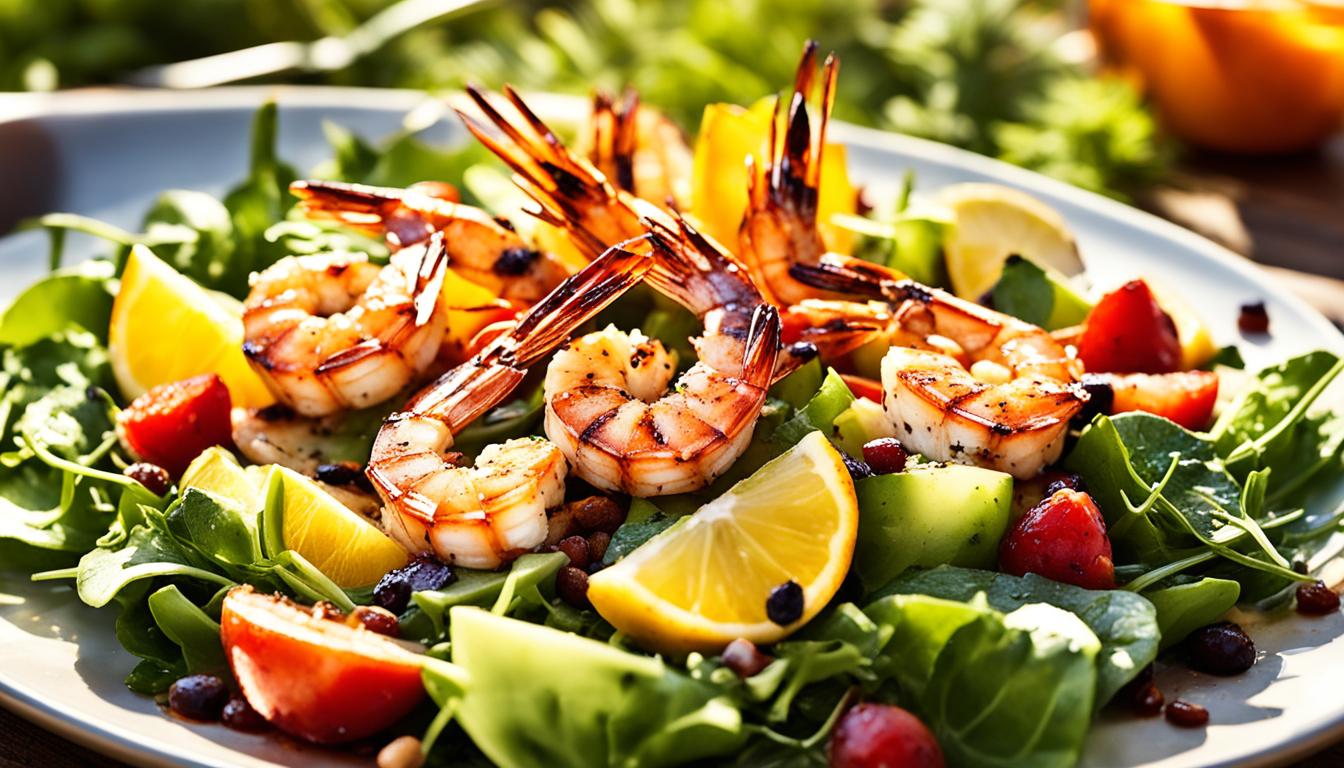Are you tired of serving the same old shrimp dish? Looking for new and exciting ways to prepare this versatile seafood? Look no further! In this article, we will explore the most popular and delicious methods of cooking shrimp, including grilling, poaching, stir-frying, and sautéing. Whether you’re a seafood aficionado or a beginner cook, these shrimp cooking techniques will elevate your dishes to a whole new level.
But first, let’s take a moment to appreciate the appeal of shrimp. With their delicate texture and sweet flavor, shrimp can be transformed into a myriad of mouthwatering recipes. They are not only quick to cook but also packed with essential nutrients. So, why settle for the mundane when you can explore the culinary possibilities of shrimp?
Key Takeaways:
- Shrimp can be prepared using various cooking techniques, including grilling, poaching, stir-frying, and sautéing.
- Choosing high-quality shrimp is crucial for achieving delicious results, so opt for sustainably sourced and properly defrosted shrimp.
- Boiling shrimp brings out their sweet essence and is perfect for dishes like shrimp cocktails and Vietnamese spring rolls.
- Grilling shrimp adds a smoky flavor and is great for surf and turf dishes or shrimp kabobs.
- Stir-frying shrimp is quick and easy, making it ideal for weeknight meals. Ginger, fish sauce, and soy sauce can be used to enhance the flavors.
The Importance of Quality Shrimp
Before we delve into the techniques of cooking shrimp, it is essential to understand the significance of using high-quality shrimp. Investing in shrimp that meets the highest standards of quality ensures a more enjoyable and satisfying culinary experience. Here’s why you should prioritize shrimp quality:
Sustainable Seafood
When buying shrimp, opt for those that are sustainably sourced. Look for labels or certifications from recognized organizations such as the Marine Stewardship Council (MSC) or the Aquaculture Stewardship Council (ASC). By choosing sustainable seafood, you support efforts to protect the ocean’s delicate ecosystems and maintain healthy shrimp populations for future generations.
Individually Quick-Frozen (IQF)
Individually quick-frozen shrimp are a convenient option that allows you to thaw only the amount you need for a specific recipe. IQF shrimp are individually frozen, ensuring easy portioning and preserving their freshness and flavor. Look for shrimp that are individually quick-frozen (IQF) to maintain their optimal quality.
Free of Additives
Avoid shrimp that contain additives or preservatives. Some shrimp may be treated with sodium tripolyphosphate (STPP) to enhance their texture and appearance. However, this additive can affect the taste and texture of the shrimp, leading to an undesirable dining experience. Choose shrimp that are free from additives for the best flavor and texture.
Defrosting Shrimp
When it comes to defrosting shrimp, it’s important to do so safely. The best method is to thaw shrimp overnight in the refrigerator. This gradual thawing process helps maintain the shrimp’s texture and prevents the growth of harmful bacteria. Avoid thawing shrimp at room temperature or using hot water, as these methods can lead to uneven thawing and compromise the quality of the shrimp.
Preparing Shrimp
Properly preparing shrimp before cooking is crucial for optimal taste and texture. Start by removing the shell and deveining the shrimp. The vein, which is the digestive tract, can impart a bitter taste if left intact. Simply make a shallow cut along the back of the shrimp, expose the vein, and lift it out with the tip of a knife or your fingers. Rinse the shrimp under cold water to ensure they are clean and ready to be cooked.
By prioritizing shrimp quality, buying sustainably sourced seafood, defrosting shrimp correctly, and properly preparing them, you set the foundation for creating exceptional shrimp dishes. Now that we understand the importance of quality shrimp, let’s explore the various cooking techniques that will elevate your culinary skills to new heights.
Boiling Shrimp
Boiling shrimp is a classic method that brings out the sweet essence of the shrimp. This technique is perfect for preparing dishes like shrimp cocktail, shrimp salad, and Vietnamese spring rolls. Boiled shrimp are tender, juicy, and full of flavor, making them a versatile ingredient in a variety of recipes.
To get started, you’ll need a pot of water and some seasoning. Bring the water to a boil and add salt or seafood seasoning to enhance the taste of the shrimp. You can also infuse the water with additional flavors like lemon, garlic, bay leaves, or chili peppers to add a delicious twist to your boiled shrimp.
Once the water is boiling and seasoned, add the shrimp and cook them until they turn pink and begin to curve. This usually takes around 2 to 3 minutes, but cooking times may vary depending on the size of the shrimp. Be sure not to overcook the shrimp as they can become tough and rubbery.
After the shrimp are cooked, remove them from the boiling water and immediately submerge them in a bowl of ice water. This quick ice bath helps stop the cooking process and ensures that the shrimp remain tender and perfectly cooked. Once the shrimp have cooled down, drain them and pat them dry before using them in your desired recipe.
Boiling shrimp is a quick and easy method that preserves the natural sweetness of the shrimp. Whether you’re making a classic shrimp cocktail, a refreshing shrimp salad, or flavorful Vietnamese spring rolls, boiled shrimp are a delicious addition to any dish. Try boiling shrimp for your next seafood recipe and enjoy the exquisite taste and texture it brings.
| Recipe | Preparation Time | Cooking Time | Serves |
|---|---|---|---|
| Classic Shrimp Cocktail | 15 minutes | 3 minutes | 4 |
| Shrimp Salad | 20 minutes | 3 minutes | 6 |
| Vietnamese Spring Rolls | 30 minutes | 3 minutes | 8 |
Grilling Shrimp
When it comes to cooking shrimp, grilling is a fantastic method that infuses a smoky flavor and imparts a delightful charred crust, elevating the overall experience. Grilled shrimp is perfect for those who enjoy the combination of succulent seafood and the unmistakable taste of the grill. Whether you want to create a smoky surf and turf dish or flavorful kabobs, grilling shrimp is a versatile technique that never disappoints.
For the best results, it’s essential to set up your grill correctly. One popular approach is to create a two-zone fire by having a hot zone and a cool zone. This setup allows you to sear the shrimp over direct heat and then finish cooking them over indirect heat, ensuring they are cooked through without becoming over-charred.

Marinating the shrimp before grilling is also a fantastic way to add extra dimensions of flavor. Consider using ingredients like lemon, garlic, or your favorite spices to create a marinade that complements the natural sweetness of the shrimp. Let the shrimp marinate for at least 30 minutes or up to a few hours to allow the flavors to penetrate the meat.
When grilling shrimp, it’s crucial to thread them onto skewers to prevent them from falling through the grates. Metal or soaked wooden skewers work well for this purpose. Gently thread the marinated shrimp onto the skewers, ensuring they are evenly spaced for even cooking.
Now, it’s time to grill the shrimp to perfection. Place the skewers over direct heat on the hot side of the grill and cook for about 2-3 minutes per side, or until they turn a vibrant pink color and become slightly curled. Avoid overcooking the shrimp, as they can quickly become tough and chewy.
Once the shrimp are cooked to your desired level of doneness, remove them from the grill and serve them hot. Grilled shrimp pairs well with a variety of side dishes, from fresh salads to grilled vegetables and seasoned rice.
| Grilling Shrimp Tips |
|---|
| 1. Preheat the grill to ensure even cooking. |
| 2. Use a two-zone fire or a gas grill with some burners ignited. |
| 3. Marinate the shrimp for added flavor. |
| 4. Thread shrimp onto skewers to prevent them from falling through the grates. |
| 5. Grill shrimp over direct heat until pink and slightly curled. |
| 6. Avoid overcooking to maintain a tender and succulent texture. |
Stir-Frying Shrimp
When it comes to quick weeknight meals, stir-frying shrimp is a go-to option. This versatile cooking method allows for the incorporation of various vegetables and spices, resulting in a delicious and balanced meal in no time. Whether you’re a seasoned cook or just getting started, stir-frying shrimp is a surefire way to satisfy your cravings.
To begin, we recommend starting with fresh, high-quality shrimp. Look for sustainably sourced options that are free of additives and individually quick-frozen (IFC) for maximum flavor and texture. Properly thaw the shrimp by placing them in the refrigerator overnight.
Now let’s dive into the stir-frying process. Heat a wok or a large skillet over medium-high heat. Add a splash of oil and wait for it to shimmer before adding the ingredients. One essential component for enhancing the flavors of stir-fried shrimp is ginger. Peel and thinly slice a piece of fresh ginger, and sauté it in the hot pan until fragrant.
Next, add minced garlic to the pan and stir-fry for a minute until it becomes aromatic. The combination of ginger and garlic creates a sublime base of flavors for the shrimp and other ingredients.
Now it’s time to add the shrimp to the pan. Make sure they are clean and deveined before cooking. Toss them into the pan and stir-fry until they turn pink and opaque, which should take about 3-4 minutes. Overcooking shrimp can result in a rubbery texture, so be mindful of the cooking time.
To elevate the umami flavors of the dish, consider adding fish sauce and soy sauce to the stir-fried shrimp. These condiments provide a savory depth that complements the sweetness of the shrimp. Adjust the seasoning to your taste preference, and continue stir-frying for another minute to allow the flavors to meld together.
Once the shrimp are cooked and well-coated with the sauce, it’s time to serve. Stir-fried shrimp pairs exceptionally well with rice or noodles, creating a complete and satisfying meal. Garnish with fresh herbs like cilantro or scallions for an added burst of freshness.
Now you’re ready to enjoy a delicious stir-fried shrimp dish that can be prepared in a breeze. Whether you’re cooking for yourself or your entire family, this quick and flavorful recipe is sure to be a hit. Let’s get stir-frying!

Sauteed Shrimp
Sauteing shrimp is a versatile cooking method that allows you to create a variety of delicious dishes. Whether you’re craving a creamy pasta or the bold flavors of international cuisine, sautéed shrimp can be your go-to for a quick and satisfying meal. With just a few simple steps, you can elevate your dinner game and impress your taste buds.
To sauté shrimp, start by heating a skillet over medium heat and adding a drizzle of oil or a pat of butter. Once the oil is hot, add the shrimp to the skillet. Make sure to use peeled and deveined shrimp for convenience and presentation.
Cook the shrimp for a few minutes on each side until they turn pink and opaque. Be careful not to overcook them, as shrimp can become rubbery if left on the heat for too long. The sweet and delicate flavor of perfectly cooked sautéed shrimp is what makes this technique so popular.
Now, let’s talk about the exciting part – seasoning and serving sautéed shrimp. The options are endless! You can go for a classic shrimp scampi with garlic, lemon, and white wine. Or, if you’re feeling adventurous, try adding international flavors like Thai chili sauce, Mexican spices, or Indian curry powder.
One of my personal favorites is sautéing shrimp with creamy pasta. The combination of tender shrimp, al dente pasta, and a rich sauce creates a comforting and satisfying dish. Whether you opt for a classic Alfredo or a zesty tomato cream sauce, sautéed shrimp will take your creamy pasta recipe to the next level.
Let your imagination run wild and experiment with different herbs, spices, and ingredients. Whether you prefer a subtle and light flavor or a bold and spicy kick, sautéed shrimp can be customized to suit your taste buds and culinary preferences.
So the next time you’re in need of a quick meal that doesn’t compromise on taste, reach for sautéed shrimp. It’s a versatile technique that opens the doors to a world of delicious possibilities!
Conclusion
Mastering shrimp cooking techniques opens up a world of delicious possibilities. Whether you prefer the sweet essence of boiled shrimp, the smoky flavor of grilled shrimp, the vibrant stir-fried creations, or the versatility of sautéed shrimp, there’s a technique to suit every palate.
Remember, it all starts with quality shrimp. Be sure to choose sustainably sourced shrimp and properly prepare them before cooking. Removing the shell and vein ensures that your shrimp are ready to absorb all the flavors you add during cooking.
Don’t be afraid to get creative with your seasonings and marinades to customize your shrimp dishes. Experiment with different flavors, spices, and herbs to create your own unique recipes that will impress your friends and family. With these cooking tips and techniques, you’ll be able to confidently prepare delicious shrimp dishes that showcase the natural flavors of this versatile seafood. Happy cooking!
